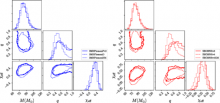
Abstract
We present a detailed investigation into the properties of GW170729, the gravitational wave with the most massive and distant source confirmed to date. We employ an extensive set of waveform models, including new improved models that incorporate the effect of higher-order waveform modes which are particularly important for massive systems. We find no indication of spin-precession, but the inclusion of higher-order modes in the models results in an improved estimate for the mass ratio of (0.3–0.8) at the 90% credible level. Our updated measurement excludes equal masses at that level. We also find that models with higher-order modes lead to the data being more consistent with a smaller effective spin, with the probability that the effective spin is greater than zero being reduced from 99% to 94%. The 90% credible interval for the effective spin parameter is now (−0.01−0.50). Additionally, the recovered signal-to-noise ratio increases by ∼0.3 units compared to analyses without higher-order modes; the overall Bayes factor in favor of the presence of higher-order modes in the data is 5.1∶1. We study the effect of common spin priors on the derived spin and mass measurements, and observe small shifts in the spins, while the masses remain unaffected. We argue that our conclusions are robust against systematic errors in the waveform models. We also compare the above waveform-based analysis which employs compact-binary waveform models to a more flexible wavelet- and chirplet-based analysis. We find consistency between the two, with overlaps of ∼0.9, typical of what is expected from simulations of signals similar to GW170729, confirming that the data are well-described by the existing waveform models. Finally, we study the possibility that the primary component of GW170729 was the remnant of a past merger of two black holes and find this scenario to be indistinguishable from the standard formation scenario.